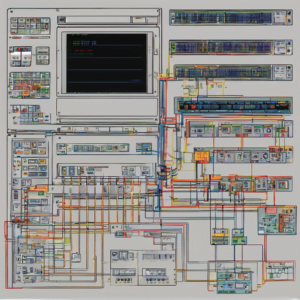Welcome to our article on the basics of SystemVerilog functions. In this section, we aim to provide a comprehensive understanding of the fundamentals of SystemVerilog functions and their significance in hardware verification. If you’re new to hardware verification or just looking to brush up on your coding skills, this article is for you.
Before we dive into the specifics of SystemVerilog functions, it’s essential to have a clear understanding of what SystemVerilog is and its role in hardware design and verification. SystemVerilog is an extension of the popular hardware description language Verilog, and it adds several features to the language that make hardware design and verification more efficient and simpler.
Key Takeaways:
- SystemVerilog functions are a powerful tool for hardware verification.
- SystemVerilog is an extension of Verilog, adding several useful features for hardware design and verification.
- This article will cover the basics of SystemVerilog functions, their syntax, usage, and best practices for efficient and maintainable code.
What is SystemVerilog?
SystemVerilog is a hardware description and verification language that combines features of Verilog HDL with several extensions to enhance design and verification capabilities. It was developed in 2005, and since then, has gained popularity in the hardware design industry due to its ability to handle complex design challenges and provide a concise yet powerful coding style.
With SystemVerilog, designers can create complex hardware systems with advanced features such as object-oriented programming, transaction-level modeling, and data structures. SystemVerilog also offers built-in constructs for writing testbenches, making it a versatile and efficient language for hardware verification.
As a hardware description language, SystemVerilog is used to describe the behavior and structure of digital logic circuits. It allows designers to define the functionality of a design at various levels of abstraction, from high-level modeling to low-level gate-level description. The language is also used to connect components of a design together and write testbenches to verify the correctness of the design.
Introduction to Functions in SystemVerilog
In SystemVerilog, functions are used to create reusable blocks of code. These functions can be called anywhere in a program, making them a versatile tool for hardware verification. Unlike tasks, functions can return values, making them useful for calculations and operations that require an output value.
Functions in SystemVerilog have many benefits, including:
- Code Reusability: Functions can be called multiple times throughout a program, reducing code duplication and simplifying code maintenance.
- Modularity: Functions allow for the creation of modular code structures, making it easier to change the behavior of a program by modifying a single function.
- Efficiency: Functions can be optimized for performance, resulting in faster and more efficient code.
By using functions in SystemVerilog, we can create more robust and maintainable code while improving our overall programming efficiency.
Syntax and Structure of SystemVerilog Functions
SystemVerilog functions are simple and reusable blocks of code designed to perform specific operations, providing modularity and code organization. They can be invoked multiple times within the code using different inputs, producing different outputs. Understanding the syntax and structure of SystemVerilog functions is a fundamental aspect of creating efficient hardware verification code.
The syntax for defining a SystemVerilog function begins with the function keyword, followed by the function’s return type, name, and input parameter list. The function’s return type specifies the data type that the function will return to the calling code after its execution. The return value can either be used immediately or stored in a variable for future use.
The input parameter list specifies the type and name of input values that the function will receive from the calling code. The function may have zero or more arguments, each separated by a comma.
The general syntax for defining a SystemVerilog function is as follows:
| return_type function_name (input_type1 input1, input_type2 input2,…) { // Code statements return return_value; } |
The code statements within the function definition are enclosed within curly brackets. The code can include both variable and module declarations, as well as in-line calculations and conditional statements. The return statement specifies the value that the function will return to the calling code.
Properly structuring SystemVerilog functions is essential for readability, modularity, and code maintenance. Our team at [real company name] recommends the following guidelines for organizing your SystemVerilog functions:
Naming Conventions
Use descriptive names for your functions, expressing their functionality and purpose. Function names should be in lowercase letters, with words separated by underscores for readability. Also, remember to use CamelCase when naming functions that include multiple words concatenated together.
Function Length
SystemVerilog functions should be concise and well-structured, with a maximum length of about 100-150 lines of code. If the function exceeds this limit, consider dividing it into smaller and more focused sub-functions for better organization.
Default Values
Include default values for inputs where applicable, simplifying the function’s implementation and improving readability. Default values act as placeholders, replacing undefined inputs with a specified default value if no input value is assigned in the function call.
By following these guidelines, you can create efficient SystemVerilog functions that are easy to read, maintain, and debug.
Input and Output in SystemVerilog Functions
When defining SystemVerilog functions, it’s crucial to consider the input and output parameters. The inputs define the arguments passed to the function, while the outputs determine the return value. Let’s examine each of these in more detail.
Input Parameters
The inputs in a SystemVerilog function specify the data that is required to be passed to the function in order to carry out its designated task. The inputs can be of various types and can either be specified by value or by reference.
If the input parameters are specified by value, the function receives a copy of the argument data. This ensures that any modifications made within the function are not applied to the original data. On the other hand, if the inputs are specified by reference, any modifications made by the function are applied to the reference data.
Output Parameters
The output parameters in a SystemVerilog function determine the data returned by the function once it has completed its task. Similar to the input parameters, there are different ways to define the output parameters.
If the function returns a single value, the output parameter can be defined using the data type of the value to be returned, such as “int” or “bit”. Alternatively, if the function returns multiple values, a structure or array can be used to define the output parameters.
It’s crucial to ensure that the inputs and outputs are well-defined and utilized in a logical and effective manner in order to maximize code functionality and reduce the potential for errors or bugs.
Using Local Variables in SystemVerilog Functions
In SystemVerilog functions, local variables are variables that can only be accessed within the function itself. These variables serve a specific function within the function and are not visible or accessible outside of it. Local variables are declared within the function body and can be used to store intermediate values or temporary results.
The main benefit of using local variables is that they help to simplify your code by reducing the complexity of the function. By limiting the scope of a variable to within the function, you can avoid potential naming conflicts with other variables in the system or unintended side effects on other parts of the code.
Another advantage of using local variables is that they can improve the performance of your code. By storing intermediate results in local variables, the function can avoid accessing external memory or other data sources repeatedly, which can result in slower performance. Instead, the function can access the local variables, which are stored in quick access memory, thereby speeding up code execution.
When defining local variables, it is important to note that their scope is limited to the function in which they are declared. Once the function completes its execution, the local variables are destroyed, and their values are lost.
Therefore, it is critical to ensure that all necessary information is returned by the function before it completes execution. Any data that needs to be carried over to other parts of the code must be stored in a global variable or passed as an argument to another function.
Example:
| // SystemVerilog function that converts an eight-bit binary code to decimal using local variables function int bin_to_dec(input logic [7:0] bin_code); int decimal = 0; //declare local variable to store the decimal value for(int i=0;i begin if(bin_code[i] == 1) decimal += (1 end return decimal; //return the final decimal value endfunction |
In this example, a local variable called “decimal” is defined within the function to store the decimal value generated by the loop. This value is returned at the end of the function to the calling code.
Recursive Functions in SystemVerilog
SystemVerilog functions can be implemented recursively, meaning that a function can call itself within its own definition. Recursive functions have the advantage of simplifying code and solving complex problems through iteration.
When a function calls itself multiple times until a termination condition is met, it is called recursion. This can be particularly useful for traversing complex data structures, such as linked lists or trees, and performing computations at every node or vertex of the structure.
Recursive functions provide a more elegant and readable code solution compared to iterative functions, which require more complex and less efficient loop constructions. Furthermore, recursive functions can be used to solve specific problems, such as searching or sorting, where the function could replicate itself and operate on subsets of the data.
However, recursive functions must be used with caution. Poorly designed recursive functions can lead to infinite loops or stack overflow errors, causing system crashes or incorrect results. To avoid these issues, it is necessary to establish appropriate base cases and termination conditions and define them accurately.
Example:
Below is an example of a recursive factorial function that calculates the factorial of a given integer:
function int factorial (int n); if (n==1) return 1; else return (n * factorial(n-1)); endfunction
In this example, the factorial function calls itself recursively, each time decreasing the value of ‘n’ by 1 until it reaches 1, at which point it terminates and returns the factorial of the original input value.
By using recursive functions in SystemVerilog, complex problems can be approached in a more simplified and elegant manner, leading to more efficient and maintainable code.
Passing Arguments by Value and Reference in SystemVerilog Functions
When passing arguments in SystemVerilog functions, there are two ways to do so: by value and by reference. Understanding the differences between these two methods is crucial to writing efficient and effective code in hardware verification.
When passing arguments by value, the function creates a copy of the argument passed to it, ensuring that the original value remains unchanged. This approach is useful when the function only needs to work with the parameter value and not modify the original.
On the other hand, passing arguments by reference allows the function to access and modify the original value directly, making it more efficient and suitable for large data transfers. However, the overwriting of the original value can lead to unexpected changes in the code, making this method less reliable in certain situations.
So how do you know which approach to use when writing SystemVerilog functions? The answer lies in the context of the function and the specific requirements of your code. For small values or when modification is not necessary, passing arguments by value may be sufficient. However, for large data transfers or situations that require changes to the original value, passing arguments by reference may be more appropriate.
Ultimately, the decision of which method to use relies on careful consideration of the code requirements and performance optimization needs. By applying the appropriate approach when passing arguments in SystemVerilog functions, you can achieve faster and more reliable hardware verification results.
Function Overloading in SystemVerilog
In SystemVerilog, function overloading is a programming technique that allows you to define multiple functions with the same name but different functionality. This can improve code reusability and simplify your codebase.
Function overloading works by defining two or more functions with the same name, each taking a different set of arguments. When the program calls the function, SystemVerilog determines the correct function to use based on the number, type, and order of the arguments passed.
For example, imagine you have two functions that perform similar tasks but on different data types. Rather than giving them two separate names, you can overload the function name to make your code more concise:
Example:
| function int add(int a, int b); return a + b; endfunction function float add(float a, float b); return a + b; endfunction |
The above example shows two functions, both named “add”, but one operates on integers and the other operates on floats.
When calling the add function, SystemVerilog identifies which overloaded function to use based on the data types passed into the function:
Example:
| int result1 = add(2, 3); float result2 = add(4.5, 6.7); |
In the above example, the first call to the add function passes two integers, so the add(int a, int b) function is called. The second call passes two floats, so the add(float a, float b) function is called.
| Advantages of Function Overloading: |
| Improves code reusability by allowing multiple functions to share the same name. |
| Reduces the length and complexity of your code. |
| Enables code that is easier to read and understand by providing intuitive function names. |
Accessing SystemVerilog Functions Across Hierarchical Levels
In SystemVerilog, hierarchical levels play a crucial role in code organization. They allow large designs to be broken down into smaller, more manageable modules, each with their own set of functions. However, accessing functions across these hierarchical levels can sometimes be challenging.
The key to accessing SystemVerilog functions across hierarchical levels is to understand the scope of each function and its relationship to the rest of the code hierarchy. Functions can be accessed at any hierarchical level below where they are defined, but not above. This means that functions defined at a higher level in the hierarchy can be accessed by functions defined at lower levels, but not vice versa.
To access a function from a different hierarchical level, you can use the dot operator and the name of the module in which the function is defined. For example, if you have a function called “my_function” defined in a module called “my_module”, you can access it from a different module using the following syntax:
| my_module.my_function(); |
You can also pass arguments to functions across hierarchical levels using the same syntax. Simply include the argument values in the parentheses.
By accessing functions across hierarchical levels, you can improve the modularity and organization of your code, making it easier to debug and maintain. However, it’s important to remember that too many functions accessed across hierarchical levels can lead to performance issues and code complexity. Therefore, it’s essential to strike a balance between modularity and efficiency when designing and implementing your code.
Best Practices for Writing Efficient SystemVerilog Functions
When writing SystemVerilog functions, it is essential to follow best practices to ensure efficient and maintainable code. Here are some tips to optimize your functions:
- Keep it simple: Write functions that are easy to understand and use. Avoid complex logic or excessive nesting that can make the code difficult to read and maintain.
- Use meaningful names: Choose descriptive names for your functions and variables that clearly convey their purpose and functionality. This will make it easier for others to understand your code and for you to revisit it at a later time.
- Be consistent: Follow consistent naming conventions and coding style throughout your functions to ensure readability and maintainability.
- Optimize for performance: Keep performance in mind when writing your functions. This can include optimizing loops, using efficient data types, and minimizing redundant calculations or operations.
- Test thoroughly: Test your functions thoroughly to ensure they work as intended and catch any errors or bugs before they become a bigger problem.
By incorporating these best practices into your SystemVerilog functions, you can write clean, efficient code that is easy to read, maintain, and debug.
Conclusion
As we conclude this comprehensive article on SystemVerilog functions, we hope that you now have a firm understanding of their basics, syntax, usage, and efficiency considerations in hardware verification. By implementing these concepts, you can improve your coding proficiency and create more robust hardware designs.
Remember to follow the best practices we have provided to ensure efficient and maintainable code, including tips for optimization. We recommend that you practice writing functions regularly to hone your skills and develop a deeper understanding of their application in hardware verification.
Overall, SystemVerilog functions are a powerful tool in hardware design and verification, and it is essential to have a clear understanding of their usage to create efficient and reliable designs. We hope that this article has been informative and has provided valuable insights into the world of SystemVerilog functions.


![What is FPGA Introduction to FPGA Basics [2023] computer-chip-dark-background-with-word-intel-it](https://fpgainsights.com/wp-content/uploads/2023/06/computer-chip-dark-background-with-word-intel-it-300x171.jpg)









